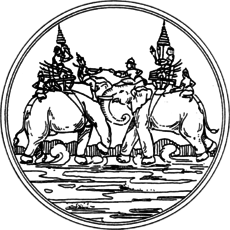Suphan Buri Province
| Suphan Buri สุพรรณบุรี | |||
|---|---|---|---|
| Province | |||
| |||
| Nickname(s): Suphan | |||
 Map of Thailand highlighting Suphan Buri Province | |||
| Country | Thailand | ||
| Capital | Suphan Buri | ||
| Government | |||
| • Governor | Suphiphat Chongphanit (since October 2013) | ||
| Area | |||
| • Total | 5,358 km2 (2,069 sq mi) | ||
| Area rank | Ranked 40th | ||
| Population (2014) | |||
| • Total | 849,053 | ||
| • Rank | Ranked 24th | ||
| • Density | 160/km2 (410/sq mi) | ||
| • Density rank | Ranked 18th | ||
| Time zone | UTC+7 (ICT) | ||
| ISO 3166 code | TH-72 | ||
Suphan Buri (Thai: สุพรรณบุรี, pronounced [sù.pʰān būrīː]) is one of the central provinces (changwat) of Thailand. Neighbouring provinces are (from north clockwise) Uthai Thani, Chai Nat, Sing Buri, Ang Thong, Phra Nakhon Si Ayutthaya, Nakhon Pathom and Kanchanaburi.
Etymology
The word suphan originates from the Sanskrit word Suvarna (Devanagari: सुवर्ण), meaning gold, and the word buri from Sanskrit purī (Devanagari: पुरी), meaning town or city. Hence the name of the province literally means 'city of gold'.
Geography
The terrain of the province is mostly low river plains, with small mountain ranges in the north and the west of the province. The southeastern part with the very low plain of the Tha Chin River is paddy rice farming area.
History
Suphan Buri might be the site of the legendary Suvarnabhumi, which is mentioned in very old Buddhist writings.[1] However the first confirmed historical settlement was in the Dvaravati period, when the city was known as Meuang Thawarawadi Si Suphannaphumi ('the Dvaravati city of Suvarnabhumi').[2] Its founding took place c. 877-882. Later it was called U Thong, and was the home city of Prince U Thong, the founder of the Ayutthaya Kingdom. King Khun Luang Pha Ngua gave it the current name. Suphan Buri was an important border city, and also the site of several battles with the neighbouring Burmese.
Symbols
The provincial seal shows the elephant battle between King Naresuan the Great and the crown prince of Burma in 1592, which took place in Suphan Buri.
The provincial tree is the ebony tree (Diospyros mollis), มะเกลือ.
Administrative divisions
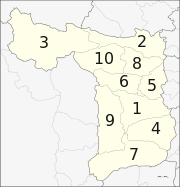
The province is divided into 10 districts (amphoe). The districts are further subdivided into 110 communes (tambon) and 977 villages (muban).
Transportation
Rail
Suphan Buri is at the end of a 157 kilometres (98 mi) branch line of the State Railway of Thailand's southern line Suphan Buri Railway Station. The branch meets the main line at Nong Pla Duk Junction near Ban Pong.
Roads
Route 340 passes through Suphan Buri, leading north to Chai Nat and south to Bang Bua Thong. Route 321 leads west and then south to Nakhon Pathom. Route 329 leads east to Bang Pahan. Route 3195 leads north-east to Ang Thong.
Tourism
Other

Wat Pa Lelai Worawihan (วัดป่าเลไลยก์วรวิหาร): It is a royal temple as evident from the royal emblem of King Rama IV on the gable of the wihan. A huge Buddha image known as ‘Luangpho To’ in the elegant image hall or Wihan is the centre of faith for Buddhist people. In the backyard of the temple is a showcase of a traditional Thai house known as ‘Khum Khun Chang’.
Industrial Promotion Centre Region 8 (ศูนย์ส่งเสริมอุตสาหกรรมภาคที่ 8): Only a kilometre away from Wat Pa Lelai, on Malai Maen Road opposite Suphan Buri Water park.
Tha Sadet Bird Park (Tha Sadet Bird Sanctuary) (สวนนกท่าเสด็จ): The sanctuary is located in private fruit orchards whose owners are kind enough to let the birds live undisturbed. Presently, the area has been developed as an attraction of the province under the management of the Royal Forestry Department.
Sa Saksit (Sacred Pond) (สระศักดิ์สิทธิ์): The six ponds here are considered as sacred ponds whose water has been used for royal ceremonies. The Fine Arts Department has registered them all as historical sites, but none has been renovated.
The Western National Theatre of Suphan Buri (โรงละครแห่งชาติภาคตะวันตกจังหวัดสุพรรณบุรี) The regional theatre is established for promoting and supplying knowledge about local cultural performances, music and classical dances of western provinces.
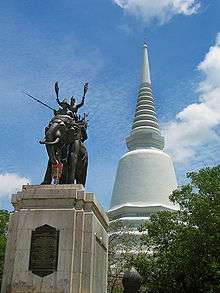
Don Chedi Monument (พระบรมราชานุสรณ์ดอนเจดีย์): The royal monument of King Naresuan the Great and the pagoda were built to commemorate the victory over the Burmese troops. The Royal Thai Army renovated the pagoda in 1952, and built a new pagoda over the ancient one.
Bueng Nong Sarai Historical Site
(โบราณสถานบึงหนองสาหร่าย): The huge lake was involved in the war when King Naresuan defeated the Burmese troops. It is pitiful that the lake, at present covering an area of only 29 rai (11.6 acres), is in poor condition.
Wat Pa Phruek’s Fish Sanctuary (อุทยานมัจฉา วัดป่าพฤกษ์): Around the temple’s waterside is a big school of various fishes such as Nile tilapia, iridescent shark-catfish, and black-eared catfish.
Buffalo Villages (บ้านควาย) features the rural lifestyle in the central region such as Thai farmer villages, rice-threshing ground water, buffalo ranch, traditional Thai houses on stilts.
Soil-less Cultivation Centre (สวนพืชไร้ดิน): The country’s largest soil-less plantation acquires an area of 200 rai. The vegetables are grown on sponge, sand, pebbles sawdust or on a hydroponics system.
Old Sam Chuk Market along Tha-Chin River (ตลาดสามชุกริมน้ำร้อยปี): This Chinese community and old-fashioned market with wooden shop houses remain in Thai original style a century ago. Banharn-Jamsai Tower.jpg Bueng Rahan (บึงระหาร): The large lake is 38 kilometres from Amphoe Mueang. Restaurants and the rest area around the lake make it a nice place for relaxing
Bueng Chawak (บึงฉวาก): This natural freshwater lake covers a huge area of over 2,700 rai (1,080 acres). The lake was declared a wildlife sanctuary area in 1983 and by its great variety of flora and fauna, the government registered Bueng Chawak as an important wetland under the Ramsar Convention. As a new destination of Suphan Buri, Bueng Chawak houses many interesting attractions as follows:
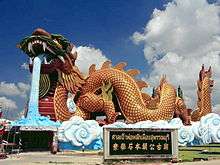
Bueng Chawak Aquarium (สถานแสดงพันธุ์สัตว์น้ำบึงฉวากเฉลิมพระเกียรติ) exhibits various species of fresh-water fish. Its first building exhibits fresh-water fishes such as Mekong giant catfish, clown feather back, bony tongue, tiger perch, etc.
Freshwater Crocodile Pond (บ่อจระเข้น้ำจืด) Landscaped for a natural look, the pond houses 60 Siamese crocodiles of 1.5-4.0 metres.
Tiger and Lion Cages(กรงเสือและสิงโต) The cages house different kinds of the cat family such as lions, tigers, clouded leopards, leopards, Indian leopard cat, as well as tiger cubs fed by milk from pigs. Nearby are rare animals such as waterfowl, peacocks, pheasants, zebra, camels, and ostriches.
Native Vegetable Garden (อุทยานผักพื้นบ้าน): The landscaped garden houses over 500 species of native vegetables nationwide, including herbs, annuals and perennials. Attractions in the compound include agricultural produce exhibition, agro-tourism centre, and nursery.
Lao Si-Lao Khrang Weaving Group (กลุ่มทอผ้าพื้นเมืองจกลวดลายโบราณลาวซี่-ลาวครั่ง) The village is the last place in the province that keeps the Lao Si-Lao Khrang textile pattern alive. Until now, the colourful woven textiles of the last century have remained.
U Thong National Museum (พิพิธภัณฑสถานแห่งชาติ อู่ทอง): It exhibits archaeological evidence and art objects from different periods found in Suphan Buri. Outside is a mock-up house in the style of the Lao Song ethnic group featuring traditions, clothing and tools.
Phu Muang Forest Park (วนอุทยานพุม่วง) Phu Muang Forest Park acquires a total area of 1,725 rai (690 acres), which is covered by mixed and bamboo forests. Its attractions include:
Nature trail (เส้นทางเดินศึกษาธรรมชาติ): The 1.5-kilometre trail leads you through forests packed with various kinds of trees such as Makha, bamboo, etc.
Ancient elephant kraal (คอกช้างดินสมัยทวารวดี): The earthen elephant kraals date back to 1,500 years ago. There are a total of three kraals covering an area of 10 rai (4 acres).
Laterite Base of Draravati Building (ฐานวิหารศิลาแลงสมัยทวารวดี): The laterite foundation dates back to the Draravati period. It is presumed to have been a venue for royal rituals before catching wild elephants.
Namtok Phu Muang (น้ำตกพุม่วง): This waterfall was mentioned in the literature Khun Chang -Khun Phaen. With five tiers, it cascades by the elephant kraal and laterite foundation. Lush forest on the mountain range, Khao Phra, has various kinds of tree and stony field where cycads dot around.
Wat Khao Di Salak (วัดเขาดีสลัก): It houses quite a special Buddha’s footprint, a bas-relief footprint carved out of red sandstone. Archaeologists presumed that the footprint is an art object of the Dvaravati style, dating back to 9th -11th century. Furthermore, Buddha images and artefacts were discovered from a rock cavity.
Agricultural Promotion and Development Centre (ศูนย์ส่งเสริมและพัฒนาอาชีพการเกษตร (พันธุ์พืชเพาะเลี้ยง)): Located in Tambon Phlapphla Chai. The centre was established to develop agriculture and plants.
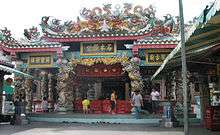
Biotechnological Pest Control Centre (ศูนย์บริหารศัตรูพืชโดยชีวภาพ) The centre educates farmers about agricultural methods to control plant pests by natural resources rather than chemical treatment. The centre comprises a nursery for attacking insects, hydroponics plant house and chemical.

Affinite Orchids (สวนกล้วยไม้แอฟฟินิท) Located at Mu 9 Tambon Chorakhe Samphan, the orchid nursery grows orchids of different families for study and sale such as Dendrobium, Cattleya, Vanda.
Wat Phai Rong Wua (วัดไผ่โรงวัว)]: Around its compound are mock-up important venues of the Lord Buddha. Furthermore, there is the world’s largest cement Buddha image, the world’s largest bronze multi-spired building known as ‘Phra Wihan Roi Yot’ and Dharmmacakra or ‘Wheel of the Doctrine’ as well as various other things in huge size. Its most exciting attraction is the "Hell Garden" with thousands of statues showing punishment in afterlife for Buddhist rules broken on earth.
Wat Thap Kradan (วัดทับกระดาน) The temple has a museum dedicated to a famous singer of Thai folk song, Phumphuang Duangchan. She spent her childhood around this temple. So, her belongings, equipment, photographs and news clipping are displayed in this temple. An annual ceremony to commemorate her death attracts lots of people to the temple.
Tham Weruwan (ถ้ำเวฬุวัน): The cave houses a Buddha image in the Pa Lelai posture. In the temple compound, district official have set up a bamboo garden in honour of Their Majesties where over 10 bamboo species are grown.
Krasiao Dam (เขื่อนกระเสียว): This country’s longest earthen dam is built on Krasiao Stream in Tambon Dan Chang. Its reservoir, with maximum water storage of 240 million cubic metres, is also a major fish-breeding site.
Phu Toei National Park (อุทยานแห่งชาติพุเตย): The park acquires a total area of 198,422 rai (79,368.8 acres). The lush forest with a lot of flora and fauna is a major watershed of Suphan Buri and Kanchanaburi. The mountain range of Phu Toei is home of thousands of mountain pines and also the best viewing point. Attractions in the park can be divided into two groups, according to its units as follows:
Unit 1 (Phu Toei) (หน่วยพิทักษ์อุทยานที่ ๑): The unit comprises a camping ground and exhibition about the forest.
Phu Toei National Park Headquarters (ที่ทำการอุทยานแห่งชาติพุเตย): The headquarters is located at Ban Huai Hin Dam, Tambon Wang Yao, Amphoe Dan Chang, 12 kilometres from Unit 1.
Mountain Pine (ป่าสนสองใบธรรมชาติ): The mountain pine forest grows up naturally on the mountain range of Phu Toei 12 kilometres from Unit 1. Four-wheel drive vehicles can only go for 10 kilometres and then trek the rest.
Giant Cycad tree (ต้นปรงยักษ์): The big cycad trees grow on Phu Toei Mountain, dotting around the pine mountain forest. At a height of 6–8 metres, each cycad tree is 200–300 years old.
Namtok Taphoen Khi (น้ำตกตะเพินคี่): The two-tier waterfall cascades all year round to nourish the forest and Karen village, which has settled there for over 200 years. Lush forests allow naturalists to enjoy ecotourism and adventure.
Taphoen Khi Karen Village (หมู่บ้านกะเหรี่ยงตะเพินคี่): The drug-and-drink-free village is Buddhist. In the full moon period of the 5th lunar month, the village holds a large celebration for three days and three nights to worship Chulamani, the sacred place of worship made from sharpened bamboo at the village’s ground.
Unit 2 (Phu Krathing) (หน่วยพิทักษ์อุทยานฯที่ 2 (พุกระทิง): The unit is located in Ban Wang Hora of Amphoe Dan Chang. Around the unit are:
Lam Taphoen Reservoir (อ่างเก็บน้ำลำตะเพิน): The large reservoir is next to the unit.
Namtok Phu Krathing (น้ำตกพุกระทิง): The waterfall is 7 kilometres from the unit, quite near to the reservoir.
Tham Nakhi, Tham Mi Noi, Tham Yoi Raya, and Tham Pha Yai (ถ้ำนาคี ถ้ำหมีน้อย ถ้ำย้อยระย้า ถ้ำผาใหญ่): These caves are only 2 kilometres away from the headquarters.
Culture
Festivals
Don Chedi Memorial Day (งานอนุสรณ์ดอนเจดีย์): The annual celebration is held on 18 January of each year. Fair goers can enjoy watching a mock-up war on elephant back, performance on stage. The fair always runs for 9 days.
Kam Fa Tradition (ประเพณีกำฟ้า): The ancient tradition of the Thai Phuan ethnic group is always held in February. Thai Phuan people will dress up in traditional attire, offering food and sweets to monks and celebrate in a large party at night. This traditional practice remains in Thai Phuan villages in Amphoe U Thong, and Tambon Makham Lom of Amphoe Bang Pla Ma.
Bun Bang Fai or Rocket Festival (ประเพณีบุญบั้งไฟ): Thai Phuan and Thai Wiang also enjoy the local rocket festival on the full moon day of the 6th lunar month, worshipping the rain god in the monsoon season. A parade of great fun will be held before the rocket launching at the temple. The tradition remains in many Tambons such as Tambon Ban Khong, Ban Kham, and Don Kha in Amphoe U Thong, and Tambon Wat Bot, and Makham Lom of Amphoe Bang Pla Ma.
Thing Krachat (งานเทศกาลทิ้งกระจาด): The merit-making festival is held annually around August–September in the municipal area. Thousands of poor people gather for free food and necessities.
Tak Bat Thewo (ประเพณีตักบาตรเทโว): A large event of merit making is always held to mark the end of Buddhist Lent in October. Buddhists prepare various food and items, particularly the so-called ‘Khaotom Luk Yon’ or seasoned sticky rice wrapped in coconut leaves to be offered to monks.
Lao Song Wedding Tradition (ประเพณีแต่งงานของไทยโซ่ง): Lao Song or Thai Song Dam ethnic group always hold a wedding ceremony during the waxing moon periods of the 4th, 6th and 12th lunar months. Thai Phuan people in Tambon Suan Taeng, Amphoe Mueang, and Tambon Ban Don, Tambon Don Makluea, and Tambon Nong Daeng of Amphoe U Thong still have such ceremony,as well.
References
- ↑ The Siam Society: Miscellaneous Articles Written for the JSS by His Late Highness Prince Damrong. The Siam Society, Bangkok, B.E. 2505 (1962). William J. Gedney, "A Possible Early Thai Route to the Sea", Journal of the Siam Society, Volume 76, 1988, pp.12-16.
- ↑ Manit Vallibhotama, "Muang U-Thong", Muang Boran Journal, Volume 14, no.1, January–March 1988, pp.29-44. Warunee Osatharom, Muang Suphan Through Changing Periods, Bangkok, Thammasat University Press, 2004).
External links

- Province page from the Tourist Authority of Thailand
- Suphanburi provincial map, coat of arms and postal stamp
- Suphanburi New Build. The new twelve lakes
| Wikimedia Commons has media related to Suphanburi. |
Coordinates: 14°28′28″N 100°7′6″E / 14.47444°N 100.11833°E
.gif)
